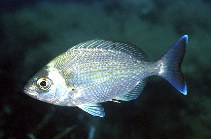Spondyliosoma cantharus (Linnaeus, 1758)
Black seabream
إضافة ملاحظاتك Fish Watcher
| Native range | All suitable habitat | Point map | Year 2050 |

|
| This map was computer-generated and has not yet been reviewed. |
| Spondyliosoma cantharus AquaMaps Data sources: GBIF OBIS |
ارفع صور و مقاطع فيديو
Pictures | Videos | صور قوقلSpondyliosoma cantharus
Picture by Patzner, R.
Pictures | Videos | صور قوقلSpondyliosoma cantharus
Picture by Patzner, R.
United Kingdom country information
Common names:
Black bream, Black sea bream, Black sea-bream
Occurrence: native
Salinity: marine
Abundance: | Ref:
Importance: | Ref:
Aquaculture: | Ref:
Regulations: | Ref:
Uses: no uses
Comments:
National Checklist:
Country Information: https://www.cia.gov/library/publications/resources/the-world-factbook/geos/uk.html
National Fisheries Authority:
Occurrences: Occurrences Point map
Main Ref: Bauchot, M.-L., 1987
National Database:
Occurrence: native
Salinity: marine
Abundance: | Ref:
Importance: | Ref:
Aquaculture: | Ref:
Regulations: | Ref:
Uses: no uses
Comments:
National Checklist:
Country Information: https://www.cia.gov/library/publications/resources/the-world-factbook/geos/uk.html
National Fisheries Authority:
Occurrences: Occurrences Point map
Main Ref: Bauchot, M.-L., 1987
National Database:
Common names from other countries
التصنيف / Names الأسماء الشائعة | مرادفات | Catalog of Fishes(جنس, الانواع) | ITIS | CoL | WoRMS | Cloffa
> Eupercaria/misc (Various families in series Eupercaria) > Sparidae (Porgies)
Etymology: Spondyliosoma: Greek, spondylos = vertebra (1667) + Greek, soma = body (Ref. 45335).
More on author: Linnaeus.
Etymology: Spondyliosoma: Greek, spondylos = vertebra (1667) + Greek, soma = body (Ref. 45335).
More on author: Linnaeus.
Environment: milieu / climate zone / depth range / distribution range البيئة
بحري قاعية التغذية و المعيشة; محيطية (Ref. 51243); نطاق العمق 5 - 300 m (Ref. 3688). Subtropical; 63°N - 20°S, 26°W - 36°E
التوزيع دول | مناطق الفاو | النظام البيئي | الظهور | Point map | مقدمة | Faunafri
Eastern Atlantic: Scandinavia to northern Namibia (Ref. 11228), including the Strait of Gibraltar, Mediterranean and the Black Sea, Madeira, Canary Islands, and Cape Verde.
Length at first maturity / الحجم / وزن / العمر
Maturity: Lm 19.7 range ? - ? cm
Max length : 60.0 cm SL ذكر/ مختلط الجنس; (Ref. 4781); common length : 30.0 cm SL ذكر/ مختلط الجنس; (Ref. 4781); أعلا وزن تم نشرة: 1.2 kg (Ref. 40637)
Max length : 60.0 cm SL ذكر/ مختلط الجنس; (Ref. 4781); common length : 30.0 cm SL ذكر/ مختلط الجنس; (Ref. 4781); أعلا وزن تم نشرة: 1.2 kg (Ref. 40637)
وصف مختصر مفاتيح التعريف | الوصف الخارجي | قياسات المظهر الخارجي
الأشواك الظهرية (المجموع) : 11; الأشعة الظهرية الناعمة (المجموع) : 11 - 13. Body tall, with weak longitudinal stripes and no dark spots. Snout as long or longer than the eye diameter (Ref. 35388).
Found over seagrass beds and rocky and sandy bottoms to about 300 m (Ref. 3688). Gregarious, sometimes in large schools (Ref. 3688). Omnivorous, feeding on seaweeds and small invertebrates, especially crustaceans (Ref. 3688). Protogynic hermaphrodites (Ref. 4781). An important food fish.
Life cycle and mating behavior النضج | التكاثر | وضع البيض | بيض | الخصوبة | Larvae
Lays eggs on sandy bottom (Ref. 4781). Sex reversal occurs at approximately 24.3 cm TL in population from Algeria (Ref. 102321). Also Ref. 28504.
المرجع الرئيسي
Upload your references | مراجع | المنظم | المتعاونين
Bauchot, M.-L. and J.-C. Hureau, 1990. Sparidae. p. 790-812. In J.C. Quero, J.C. Hureau, C. Karrer, A. Post and L. Saldanha (eds.) Check-list of the fishes of the eastern tropical Atlantic (CLOFETA). JNICT, Lisbon; SEI, Paris; and UNESCO, Paris. Vol. 2. (Ref. 3688)
IUCN Red List Status (Ref. 130435: Version 2024-2)
Least Concern (LC) ; Date assessed: 18 August 2009
خطر للأنسان
Harmless
استخدامات بشرية
مصائد: تجاري; لعبة سمكه: نعم; حوض مائي: احواض مائية عامة
FAO(مصائد: الأنتاج; publication : search) | FishSource | البحر حولنا
مزيد من المعلومات
Population dynamics
معاملات النمو
Max. ages / sizes
Length-weight rel.
Length-length rel.
الطول- الترددات
Mass conversion
توظيف
الوفرة
معاملات النمو
Max. ages / sizes
Length-weight rel.
Length-length rel.
الطول- الترددات
Mass conversion
توظيف
الوفرة
Physiology
Body composition
Nutrients
استهلاك الأوكسجين
نوع السباحة
سرعة السباحة
Visual pigments
Fish sound
Diseases & Parasites
Toxicity (LC50s)
Body composition
Nutrients
استهلاك الأوكسجين
نوع السباحة
سرعة السباحة
Visual pigments
Fish sound
Diseases & Parasites
Toxicity (LC50s)
Genetics
جيني
Heterozygosity
التوريث
جيني
Heterozygosity
التوريث
Human related
Aquaculture systems
ملامح تربية الأحياء المائية
سلالات
Ciguatera cases
Stamps, coins, misc.
Aquaculture systems
ملامح تربية الأحياء المائية
سلالات
Ciguatera cases
Stamps, coins, misc.
أدوات
Bio-Quiz | E-book | دليل الميدان | مفاتيح التعريف | Length-frequency wizard | أداة تاريخ الحياة | نقطة علي الخريطة | Classification Tree
| Catch-MSY |
تقارير خاصة
البحث عن صيانت الأحواض المائيه | التحقق من وجود صفحات حقائق الأنواع | البحث عنا حقائق حول الأحواض المائيه
Download XML
مصادر علي الأنترنت
Aquatic Commons | BHL | Cloffa | Websites from users | البحث في مراقبي الأسماك | CISTI | Catalog of Fishes(جنس, الانواع) | DiscoverLife | DORIS | ECOTOX | Faunafri | Fishtrace | GenBank(الوراثة, نيوكلوتيدة) | GloBI | GOBASE | | Google Books | Google Scholar | Google | IGFA World Record | MitoFish | قاعدة البينات الوطنية | Otolith Atlas of Taiwan Fishes | احواض مائية عامة | PubMed | Reef Life Survey | Scirus | SeaLifeBase | شجرة الحياة | Wikipedia(ذهب, بحث) | World Records Freshwater Fishing | سجلات علم الحيوانات
Estimates based on models
Preferred temperature (Ref. 115969): 7 - 17.2, mean 10.2 (based on 645 cells).
Phylogenetic diversity index (Ref. 82804): PD50 = 0.7500 [Uniqueness, from 0.5 = low to 2.0 = high].
Bayesian length-weight: a=0.01230 (0.01113 - 0.01359), b=3.03 (3.00 - 3.06), in cm Total Length, based on LWR estimates for this species (Ref. 93245).
مستوى غذائي (Ref. 69278): 3.3 ±0.2 se; based on diet studies.
المرونه (Ref. 120179): وسيط, الحد الزمني الأدني لتضاعف عدد أفراد المجتمع 1.4-4.4 سنة (K=0.3; Fec=36,000; tm=4).
Prior r = 0.47, 95% CL = 0.31 - 0.71, Based on 3 data-limited stock assessments.
Fishing Vulnerability (Ref. 59153): Moderate vulnerability (37 of 100).
Climate Vulnerability (Ref. 125649): Moderate vulnerability (41 of 100).




